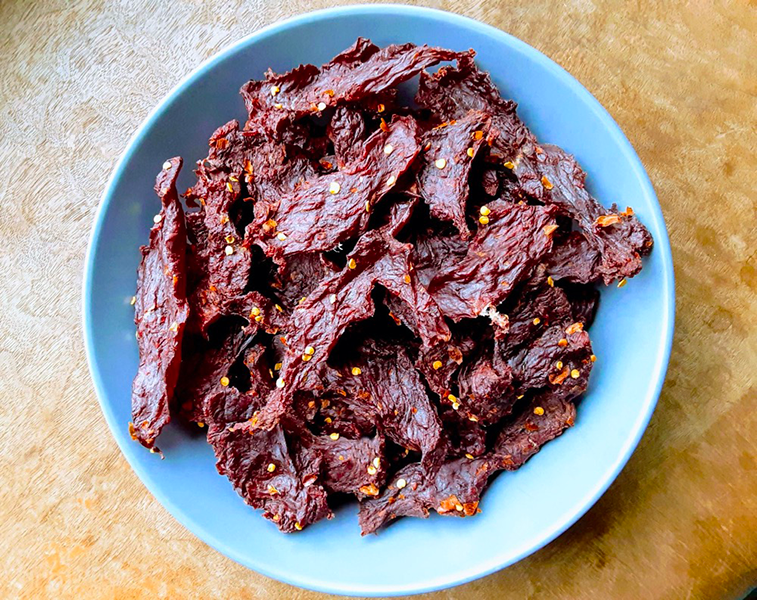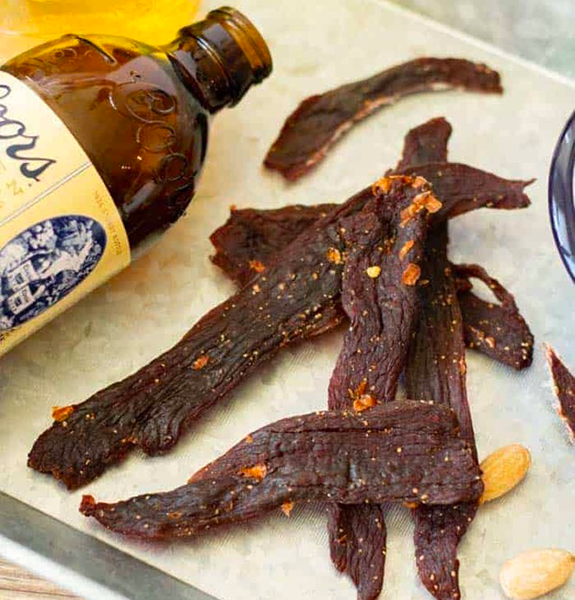
Content Menu
● Understanding the Basics of Jerky Making
● Ingredients You Will Need
● Step-by-Step Guide to Making Deer Jerky
>> Step 1: Prepare the Meat
>> Step 2: Preheat Your Dehydrator
>> Step 3: Arrange the Meat in the Dehydrator
>> Step 4: Dehydrate
>> Step 5: Cool and Store
● Tips for Perfect Jerky
● Flavor Variations for Deer Jerky
● Common Mistakes to Avoid
● Nutritional Benefits of Deer Jerky
● Storing Your Deer Jerky
● Additional Techniques for Making Jerky
>> Using Seasoning Blends
>> Vacuum Sealing Your Jerky
● The Science Behind Dehydration
● Serving Suggestions for Deer Jerky
● Final Thoughts on Making Deer Jerky
● Conclusion
● FAQ
>> 1. Can I use other meats besides venison?
>> 2. How long does homemade jerky last?
>> 3. Is it necessary to marinate the meat?
>> 4. What temperature should I set my dehydrator?
>> 5. Can I make jerky without a dehydrator?
● Citations:
Making deer jerky is a rewarding process that not only provides a delicious snack but also allows you to preserve your game meat effectively. Using a food dehydrator simplifies the process, ensuring even drying and optimal flavor. This guide will take you through the steps of making deer jerky using a food dehydrator, covering everything from selecting the right meat to storing your finished product.

Understanding the Basics of Jerky Making
Jerky is essentially dehydrated meat, and the process of making it involves removing moisture to inhibit bacterial growth while enhancing flavor. Here are some key points to consider:
- Meat Selection: The best cuts for jerky are typically lean cuts with minimal fat, such as the backstrap, hindquarters, or flank of the deer. Fat can go rancid over time, affecting the shelf life of your jerky.
- Marinade: A good marinade not only adds flavor but also helps in the preservation process. Common ingredients include soy sauce, Worcestershire sauce, garlic powder, and various spices.
- Dehydration Temperature: The USDA recommends heating red meat to at least 160°F (71°C) before dehydration to kill harmful bacteria.
Ingredients You Will Need
To make deer jerky, gather the following ingredients:
- 1 pound venison (sliced into 1/4 inch strips)
- 3/4 cup soy sauce
- 1 tablespoon brown sugar
- 1 teaspoon liquid smoke (optional)
- 1 teaspoon salt
- 1/2 teaspoon minced garlic
- 1/2 teaspoon ground black pepper
- Optional spices: red pepper flakes, onion powder, or any other preferred seasonings
Step-by-Step Guide to Making Deer Jerky
Step 1: Prepare the Meat
1. Slice the Venison: Cut the venison into thin strips against the grain. This helps in achieving a tender texture.
2. Marinate: In a large bowl or resealable plastic bag, mix all marinade ingredients. Add the sliced venison and ensure each piece is well-coated. Seal and refrigerate for at least 4 hours or overnight for best results.
Step 2: Preheat Your Dehydrator
Set your food dehydrator to a temperature between 150°F and 160°F (65°C - 71°C). This range is optimal for drying without cooking the meat.
Step 3: Arrange the Meat in the Dehydrator
1. Remove from Marinade: Take the venison out of the marinade and pat dry with paper towels to reduce excess moisture.
2. Place on Trays: Lay the strips out on dehydrator trays in a single layer, ensuring they do not touch each other. This allows air to circulate freely around each piece for even drying.
Step 4: Dehydrate
Insert the trays into your dehydrator and let it run for approximately 4 to 8 hours. The exact time will depend on factors like thickness of strips and humidity levels. Check for doneness by bending a piece; it should be firm but still flexible without breaking.
Step 5: Cool and Store
Once dried, allow your jerky to cool completely at room temperature before storing it in an airtight container or vacuum-sealed bag. Properly dried jerky can last for several months when stored in a cool, dark place.

Tips for Perfect Jerky
- Rotate Trays: If your dehydrator has multiple trays, rotate them halfway through drying to ensure even exposure to heat.
- Check Frequently: Start checking your jerky after about 3 hours to prevent over-drying.
- Use a Thermometer: A meat thermometer can help ensure that your jerky reaches safe temperatures during initial cooking.
Flavor Variations for Deer Jerky
One of the joys of making deer jerky is experimenting with different flavors. Here are some variations you can try:
- Spicy Jerky: Add cayenne pepper or hot sauce to your marinade for an extra kick.
- Sweet and Savory: Incorporate honey or maple syrup into your marinade for a sweet contrast to the savory flavors.
- Herb-Infused Jerky: Use fresh herbs like rosemary or thyme in your marinade for an aromatic touch.
Common Mistakes to Avoid
When making deer jerky, it's essential to avoid common pitfalls that can affect flavor and texture:
- Using Too Much Fat: As mentioned earlier, fat can lead to rancidity. Always opt for lean cuts of meat.
- Inadequate Marinating Time: Skimping on marinating time can result in bland jerky. Aim for at least four hours; overnight is ideal.
- Overcrowding Trays: Placing too many pieces on a tray can lead to uneven drying. Always leave space between pieces.
Nutritional Benefits of Deer Jerky
Deer jerky is not only delicious but also offers several nutritional benefits:
- High Protein Content: Jerky is an excellent source of protein, making it a great snack for those looking to build muscle or maintain energy levels during outdoor activities.
- Low in Fat: When made from lean cuts, deer jerky is lower in fat compared to many commercial snack options.
- Rich in Nutrients: Venison contains essential vitamins and minerals such as B vitamins (B6 and B12), iron, and zinc.
Storing Your Deer Jerky
Proper storage is crucial for maintaining the quality of your homemade deer jerky:
- Airtight Containers: Store your jerky in airtight containers or vacuum-sealed bags to prevent moisture absorption.
- Cool Storage Locations: Keep your jerky in a cool, dark place like a pantry or refrigerator. Avoid exposure to heat sources which can degrade quality over time.
Additional Techniques for Making Jerky
In addition to using marinades, there are other techniques that can enhance your jerking experience:
Using Seasoning Blends
Instead of traditional marinades, consider using dry seasoning blends specifically designed for jerking meats. These blends often contain salt, sugar, spices like paprika or black pepper, and sometimes preservatives that help enhance flavor while extending shelf life.
1. Dry Rub Method: Apply dry rubs directly onto the meat before placing it in the dehydrator.
2. Homemade Seasoning Mix: Combine equal parts salt and sugar with your favorite spices such as garlic powder or smoked paprika for a simple yet effective seasoning mix.
Vacuum Sealing Your Jerky
Vacuum sealing not only helps preserve freshness but also enhances flavor by removing air from storage bags:
- Use a vacuum sealer after cooling your jerky completely.
- Vacuum-sealed bags can extend shelf life significantly compared to regular storage methods by preventing oxidation and moisture buildup.
The Science Behind Dehydration
Understanding how dehydration works can improve your results:
1. Moisture Removal: The primary purpose of dehydration is moisture removal which inhibits bacterial growth.
2. Temperature Control: Maintaining consistent temperatures ensures even drying without cooking the meat too quickly which could lead to tough textures.
3. Airflow: Proper airflow within your dehydrator allows moisture-laden air to escape while fresh air circulates around each piece of meat effectively promoting even drying throughout all trays used during processing.
Serving Suggestions for Deer Jerky
Once you've made your delicious deer jerky, consider these serving suggestions:
- Serve as an appetizer alongside cheese platters during gatherings.
- Pair with nuts or dried fruits for an energy-packed trail mix perfect for hiking trips.
- Use as toppings on salads or incorporate into stir-fries adding protein-rich goodness effortlessly!
Final Thoughts on Making Deer Jerky
Making deer jerky at home allows you not only control over ingredients but also provides satisfaction knowing you crafted something delicious from scratch! Whether you're preparing snacks ahead of hunting season or simply looking for nutritious alternatives when snacking throughout daily life—homemade deer jerkey offers endless possibilities tailored just right according personal preferences!
Conclusion
Making deer jerky with a food dehydrator is not only straightforward but also allows you to customize flavors to your liking. With proper preparation and attention to detail, you can create delicious jerky that serves as a perfect snack for outdoor adventures or everyday munching. By following this guide, you'll be able to enjoy homemade deer jerky that rivals store-bought options while knowing exactly what goes into it.

FAQ
1. Can I use other meats besides venison?
Yes, you can use beef, turkey, or even fish! Just ensure that you follow similar marinating and dehydration processes.
2. How long does homemade jerky last?
When stored properly in an airtight container in a cool place, homemade jerky can last up to several months.
3. Is it necessary to marinate the meat?
While marinating enhances flavor and helps with preservation, it's not strictly necessary if you prefer plain jerky.
4. What temperature should I set my dehydrator?
The ideal temperature range is between 150°F and 160°F (65°C - 71°C) for safe drying without cooking the meat.
5. Can I make jerky without a dehydrator?
Yes! You can use an oven set at its lowest temperature with airflow by propping the door open slightly or using a fan.
Citations:
[1] https://mountaingirl.camp/venison-jerky/
[2] https://www.outdoorlife.com/gear/how-to-make-deer-jerky/
[3] https://www.dreamstime.com/photos-images/food-dehydrator.html
[4] https://www.youtube.com/watch?v=mtDzdYoyeR8
[5] https://spicedblog.com/homemade-venison-jerky/
[6] https://1898mama.com/how-long-to-dehydrate-deer-jerky-how-to-make-it/
[7] https://www.youtube.com/watch?v=rR2G5UO-5Ms
[8] https://hyde.ces.ncsu.edu/2020/12/venison-jerky-dehydrating-meat/
[9] https://www.youtube.com/watch?v=FVdAnWD3vJA
[10] https://www.nesco.com/recipe/grandpas-venison-jerky-dehydrator/











